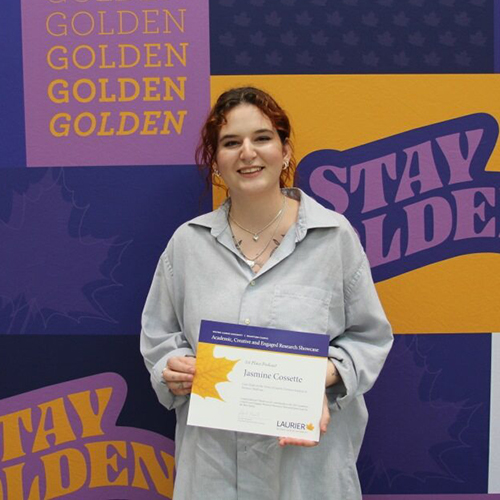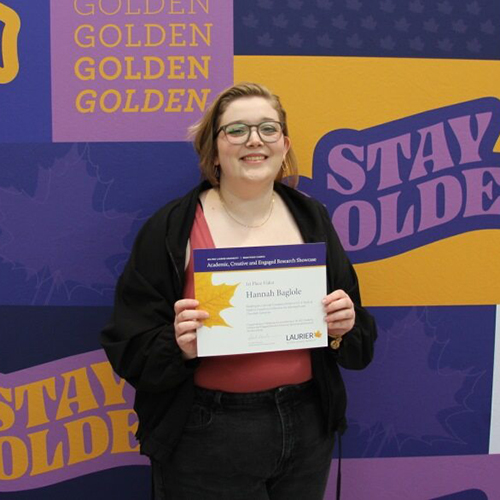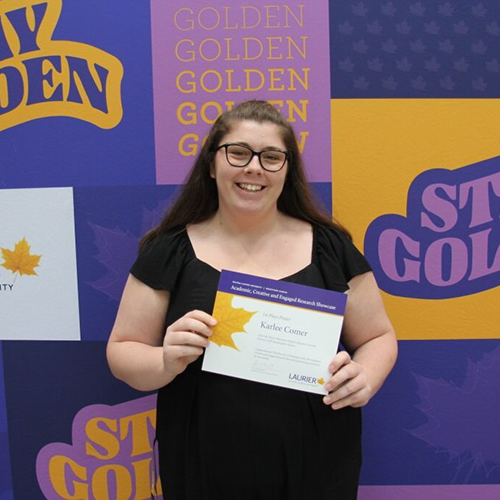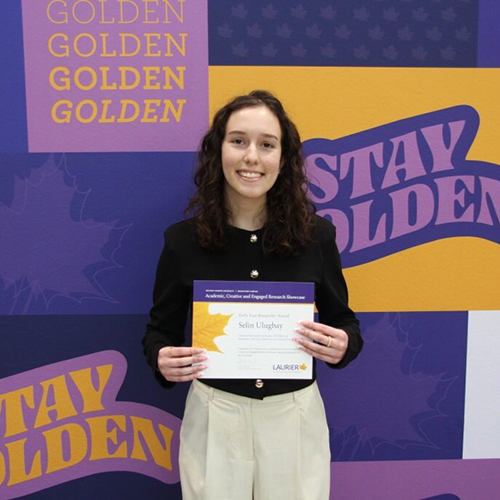We use cookies on this site to enhance your experience.
By selecting “Accept” and continuing to use this website, you consent to the use of cookies.
Search for academic programs, residence, tours and events and more.
April 3, 2025
Print | PDFStudents, faculty, staff and members of the public celebrated outstanding undergraduate student research at Wilfrid Laurier University’s Academic, Creative and Engaged Research Showcase (ACERS) on March 20.
Hosted at Laurier’s Brantford campus, the ninth annual ACERS event provided an opportunity for students to present multidisciplinary research projects to peers and the university community while competing for more than $5,000 in cash prizes.
Thanks to a generous donation from the Race family, grand prize winners in the categories of poster, podcast and video received $750 each. Second- and third-place winners in each category received $500 and $250, respectively. Six submissions received honourable mention prizes of $100 each and the Early Year Researcher Award granted $500 to a submission by a first- or second-year student.
Congratulations to all the ACERS 2025 award winners!

A fourth-year student double-majoring in Criminology and Forensic Psychology, Jasmine Cossette was initially a bit anxious taking on the case study she was assigned in Forensic Lab Methods. Nevertheless, the skill and sensitivity with which she handled the subject — a tragic case of infanticide — convinced her professor, Nathan Vo, to nominate her research for ACERS.
Her resulting first-place win in the podcast category is a poignant bookend to her time at Laurier Brantford, and as Vo’s student.
“After I took his Introduction to Forensic Science course, Professor Vo reached out to me and offered me a position in his research group,” Cossette says. “I’ve been working in his lab for the past three years and became his teaching assistant for Introduction to Forensic Science. He's given me so many amazing opportunities — including this ACERS nomination.”
Your research project focuses on the application of gastric content analysis. How is that used in forensic investigation?
JC: Gastric content analysis can be useful for determining the time of death. Investigators compare the volume of the deceased’s last meal to what’s left in the stomach, against standard equations for how quickly the stomach empties. Essentially, it measures the length of time that has passed between the last meal and death.
What are the drawbacks of this method?
JC: It's not always the most reliable: There are many factors that can influence gastric emptying, including personal health, an individual’s metabolism and the type and size of the meal itself.
Yet you found gastric content analysis was useful in your case study — why?
JC: In infant cases, there are fewer factors that contribute to the variability of gastric emptying. Babies under a year old will be given formula or milk — liquid — and that empties at a more reliable rate than solids that can vary in size and composition. Plus, there are fewer lifestyle habits that can influence the rate of emptying.
So where does gastric content analysis fit in a forensic investigator’s toolkit?
JC: In forensic science, no single time of death estimator can be applied to every case. Although gastric content analysis is controversial, it can be very useful in cases like this. There just needs to be more research, as well as a standardization of the procedure and a better understanding of what contributes to delays and accelerations in gastric emptying.
How accurate are depictions of forensic pathology in pop culture?
JC: I used to love the show Bones, but it drives me crazy how the characters jump to conclusions. They’ll see one piece of evidence — and granted, they usually have the science right — but they’ll immediately have a person of interest and five minutes later they’re arrested. And, of course, it’s the scientist doing the arresting. It triggers me in a way that I can't watch it anymore!”
2nd place: Ashley Di Biase and Carissa Muise — Bridging Worlds
3rd place: Clara Patey — Social Contagion: How Social Media Alters Users Self Perceptions of Mental Health
Honourable mentions:

The study of women’s history has always been a passion for fourth-year History student Hannah Baglole. That enthusiasm shines through in her prize-winning ACERS video.
Baglole’s research into the history of Canadian girlhood began in a fourth-year seminar class under the supervision of Tarah Brookfield, associate professor of History and Youth and Children’s Studies. The format of the research was to be a historiography — a study of the written history of a subject — a format Baglole had never before tackled.
What did you learn from conducting your first historiography?
HB: I learned a lot about how we link a historical narrative together. It’s one thing to read one author’s opinion or one historical narrative, but it’s another to read a bunch of different authors, opinions and stories and see where they connect. It gives you a bigger picture of how the historical narrative has been constructed over time, what information is missing and what needs further study.
What information is missing from the history of Canadian girlhood?
HB: All of the works that I studied were about white modern girlhood: None of them specifically addressed Indigenous, Asian, Japanese or Black girlhood. Some did address that was because of a lack of sources, but a lot of them didn’t really touch on marginalized girls at all.
In the video, you mention that studying girls’ history can be difficult. Why is that?
HB: I think it’s because — especially with archival research — a lot of things made by girls are not preserved at all. Kristine Alexander, who wrote a book on the Girl Guides that was included in my historiography, has observed that the history of childhood is written by adults. It’s very difficult to look for girls’ voices in history because they are not given the same voice that women and men are, or even boys. They were not seen as important.
Are there any next steps for your research?
HB: I’m now going into my fourth-year writing seminar and I’ll be focusing on the history of the Girl Guide movement during the Cold War in Canada, including how it affected Indigenous communities.
2nd place: Vanessa Currado — Looking Up! How Birdwatching Inspires Awe and Enhances Well-Being
3rd place: Natalia Luciani — Immersive Virtual Reality Meditation and Acute Stress Regulation
Honourable mentions:

Karlee Comer
Although Karlee Comer’s award-winning poster focused on a news story that dominated headlines in the spring of 1993, her research wasn't conducted for a history course. Instead, the fourth-year Criminology student examined the fiery siege of a religious cult’s compound in Waco, Texas through the lens of forensic science.
What made the Waco siege significant from a forensic standpoint?
KC: In this case study, there were 76 deaths, mostly due to fire. DNA degradation made it really difficult to obtain full genetic profiles and cross-contamination was a huge concern. As a result, it was the first time a process called STR quadruplex analysis was used to identify victims in a mass disaster.
Does STR quadruplex analysis complement other investigative techniques?
KC: In Waco, they combined the techniques of STR quadruplex with paternity-style DNA analysis, which looks for DNA matches with surviving parents and children. These two methods worked well together and made it possible to positively identify many of the victims.
Do forensic investigators continue to rely on STR quadruplex, more than 30 years on?
KC: In a typical case, where there’s a single victim or more conventional means of identifying them, it probably wouldn’t be the first forensic tool an investigator would choose. But in a mass disaster, where there are dozens or even hundreds of victims, it can still be useful.
What was it like presenting your research at ACERS?
KC: I’m really glad Laurier has something like this. It’s a great opportunity for student researchers to present our work and it gives us skills and experience we don’t normally get in the classroom — experience that will come in handy if I choose to pursue a master’s in Criminology.
2nd place: Elisha Felician — Decolonizing Climate Change Narratives
3rd place: Kate Fretz — User Experience and Gamification: Understanding Effective Game Mechanics and the Flow State Within Digital Experiences
Honourable mentions:

After winning the ACERS Early Year Researcher Award recognizing the top project from a first- or second-year student, Selin Ulugbay had one question on her mind: “Do you think I can compete again next year?”
Currently in her second year of a combined double major in Criminology and Psychology, Ulugbay’s ambitions extend far beyond future ACERS competitions.
“My goal is to become a criminal defence lawyer,” she says. “I hope one day to be an advocate for a more trauma- and mental health-informed justice system.”
Ulugbay currently pursues that advocacy through Laurier Brantford’s Research Apprenticeship Program, in which she developed the poster that would earn her this ACERS win. Under the mentorship of Professor Stacey Hannem, her examination of how mandatory minimum sentences contribute to Indigenous people’s overrepresentation in prisons is driven by a desire for criminal justice reform.
Are there any measures in place to reduce the overrepresentation of Indigenous offenders in Canadian prisons?
SU: Gladue principles, implemented by the Supreme Court of Canada, require judges to consider the background of Indigenous offenders and how colonialism, residential schools and intergenerational trauma could have had an impact on bringing offenders to the court. They also encourage judges to consider alternative sanctions that would be more appropriate than jail.
What's preventing these principles from achieving their intended purpose?
SU: Mandatory minimum sentences directly contradict Gladue principles. One of the main problems — and it’s one that’s been acknowledged by the government — is that mandatory minimum sentences disproportionately affect marginalized people, including Indigenous and Black peoples. Because of this, many mandatory minimum sentences were repealed in 2021 — but a lot stay in place.
Can a judge overrule a mandatory minimum sentence?
SU: Yes, and that was one of the most surprising things I discovered in my research: A judge can overturn a mandatory minimum sentence if they find it to be “grossly disproportionate.” My research includes a review of 75 cases involving Gladue factors and mandatory minimum sentences. In 39% of those cases, sentences were overruled by judges as unduly harsh. It was interesting to then look into how judges decide what is grossly disproportionate and what is not.
Where are you taking your research from here?
SU: I’m working on writing a final research paper and an analysis of my findings and hopefully publishing that. I presented this research at the Criminology Student Association Conference and I’ve also been invited to present at the Justice, Crime and Deviance Conference, hosted by Laurier’s Criminology grad students. In June, I’ll present at the Qualitative Analysis Conference in Quebec City. I’m excited to share my research and I’d like to see it — and similar research in the field — used to inform policy decisions.
Check out all the research projects submitted for ACERS 2025.